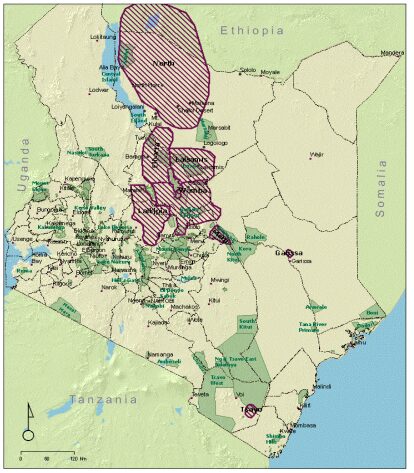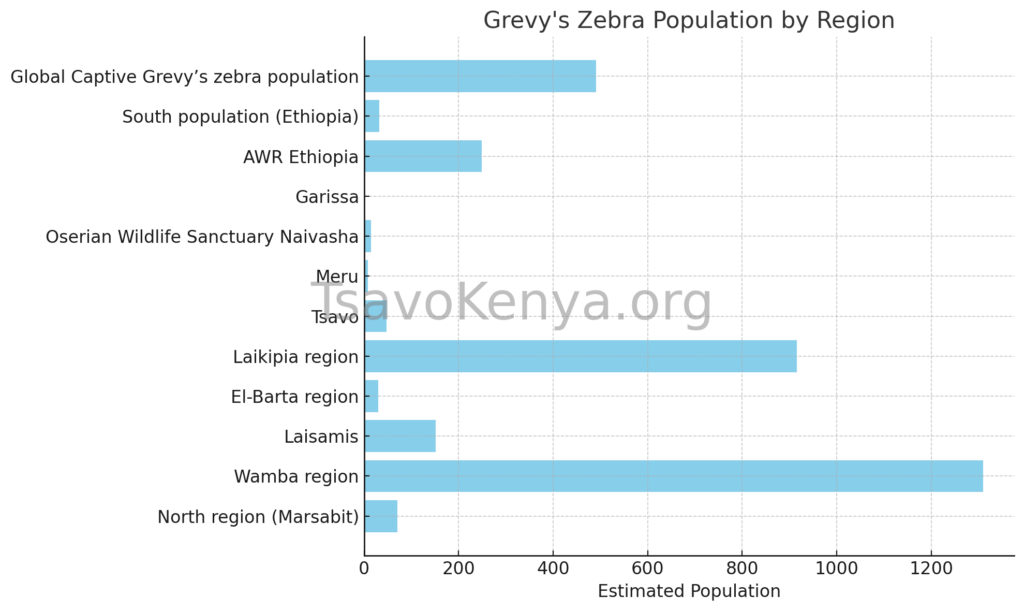Introduction to Grevy’s Zebra
Grevy’s zebra (Equus grevyi) is a distinct species of zebra, recognized for its unique narrow stripes and larger size compared to the more common Burchell’s zebra. Once distributed over a vast range that covered parts of northern Kenya, Somalia, and Ethiopia, the natural range of Grevy’s zebra has become significantly restricted due to habitat loss, human-wildlife conflict, and poaching.
Population Decline:
Grevy’s zebra populations have sharply decreased from approximately 15,000 individuals in the 1970s to under 2,500 today. Their historical range, which once extended across northern Kenya, Somalia, Ethiopia, and parts of Eritrea, is now confined to fragmented regions in northern Kenya and small areas in southern Ethiopia. Currently, the zebra population in Kenya is estimated to be between 1,600 and 2,000, reflecting an 85% decline over the past three decades.

Grevy’s Zebra in Tsavo: Historical Context
The Tsavo Conservation Area (TCA), encompassing both Tsavo East and Tsavo West, has played a pivotal role in protecting Grevy’s zebra as their numbers dwindled. In the 1960s and 1970s, conservationists and wildlife managers undertook an ambitious translocation program to reintroduce Grevy’s zebras into the Tsavo parks.
According to a study by Mwangi Githiru, 22 Grevy’s zebras were released into Tsavo East National Park in 1964, followed by 30 zebras being introduced into Tsavo West National Park in 1977. This initiative was driven by the limited protected range of Grevy’s zebra in Kenya, where less than 0.5% of their natural habitat was within protected areas. The goal of the translocations was to provide these endangered zebras with a safer refuge within the TCA, thereby enhancing their conservation and ensuring a more secure future for the species.
Current Population and Challenges
Despite the initial success of translocation, the Grevy’s zebra population within the TCA remains small and fragmented. Estimates suggest that there are only about 18-50 Grevy’s zebras within Tsavo East National Park (TENP) and Tsavo West National Park (TWNP) as per TCA’s Management Plan. This number is considered ecologically unviable, primarily due to low population densities and skewed sex ratios, which limit the zebras’ ability to reproduce successfully.
As noted by Sheldrick wildlife Trust’s blog, an aerial game count in February 2014 revealed only 26 Grevy’s zebras remaining in the Tsavo area, mainly outside Tsavo East in neighboring ranches. These zebras have been observed with young foals, which is encouraging for future reproduction.
Further complicating conservation efforts are the diseases, predation, and hybridization with the more common Burchell’s zebra, which poses a genetic dilution risk. The zebras’ wide dispersion across the TCA and adjacent areas, including Taita ranches, makes it difficult to monitor and manage the population effectively.

Conservation Efforts: The Road Ahead
To address the challenges facing Grevy’s zebra in the TCA, the National Grevy’s Zebra Conservation Strategy outlines several key objectives aimed at ensuring the establishment of viable populations and habitats for this endangered species.
1. Establishment of a Grevy’s Zebra Site Committee
One of the first steps is to form a site committee that will oversee conservation activities across the TCA and neighboring areas. This committee will include representatives from regions where Grevy’s zebras are found, including Tsavo East, Tsavo West, and the Taita ranches. The committee’s role will be to coordinate efforts and bring together all stakeholders, including local communities and government agencies, for a landscape-level approach to zebra conservation.
2. Comprehensive Population Census
Accurate data on the Grevy’s zebra population within the TCA and its surrounding areas is essential. The strategy proposes a comprehensive census of the population to assess population size, health, and genetic diversity. This will include ground counts and aerial surveys to provide a more precise understanding of zebra distribution and status. Additionally, specific studies will explore the impacts of disease and hybridization with Burchell’s zebra, which could negatively affect genetic integrity.
Collaboration between Marwell Wildlife, David Sheldrick Wildlife Trust, Tsavo Trust, and others is focused on monitoring the zebras and building a database using photographs to track and identify individuals. A software system is in development to identify zebras by their unique stripes.
3. Disease Control and Management
The Grevy’s zebra population has been vulnerable to diseases, especially anthrax, which has led to significant losses in other parts of their range. The conservation strategy aims to implement targeted disease surveillance and preventive measures to protect the remaining zebra population within the TCA. This may include vaccination programs and the monitoring of water sources to prevent outbreaks.
4. Development of a Sanctuary
Given the risks of inbreeding and the low reproductive rates, a sanctuary dedicated to genetically pure Grevy’s zebras may be established to form the core breeding population. This sanctuary would help mitigate some of the challenges posed by the zebra’s fragmented range and low numbers. However, the feasibility of such a sanctuary remains under study, as the costs and ecological impacts must be carefully evaluated.
The Future of Grevy’s Zebra in Tsavo
With the efforts outlined above, the future of Grevy’s zebra in the TCA looks cautiously optimistic. The translocation efforts in the 1960s and 1970s were a crucial first step, but the journey to ensure the species’ long-term survival will require ongoing collaboration, research, and targeted management actions.
Key Objectives Moving Forward:
- Enhance Population Viability: Through continuous monitoring and management, the goal is to establish a population that can thrive on its own.
- Foster Ecosystem Health: Protecting and restoring the habitats that sustain Grevy’s zebra, including key grasslands and water sources, will help create a more sustainable environment.
- Community Engagement: Working closely with the local communities and stakeholders to ensure that Grevy’s zebra conservation becomes a shared responsibility, fostering cooperation between wildlife managers and local people.
With these steps in place, Tsavo can continue to play a critical role in Grevy’s zebra conservation, serving as a refuge for the species and a model for future conservation efforts aimed at safeguarding other endangered species across Africa.
Why are Grevy’s Zebra Endangered?
Grevy’s zebras are considered endangered due to a combination of factors that impact their survival, both in the wild and within protected areas like Tsavo. Despite translocation efforts in the past, their population has not grown rapidly for several reasons:
- Habitat Loss and Fragmentation: Human activity has reduced their natural range, leaving them confined to small, fragmented habitats, limiting movement and reproduction.
- Low Genetic Diversity and Inbreeding: Small population sizes lead to inbreeding, reducing genetic diversity and overall fitness, making the species more vulnerable to disease and reproduction challenges.
- Skewed Sex Ratios: A disproportionate number of males to females limits breeding opportunities, slowing population growth.
- Hybridization with Burchell’s Zebra: Interbreeding with Burchell’s zebra dilutes the species’ genetic integrity, hindering efforts to preserve them as a distinct species.
- Predation: Large predators in Tsavo, such as lions and hyenas, put additional pressure on the zebra population, especially young or weak individuals.
- Diseases: Outbreaks, like anthrax, have caused significant mortality, further decreasing numbers.
- Limited Protected Areas: Only 0.5% of their range is within protected areas, making them more vulnerable to human-wildlife conflict outside parks.
- Climate Change: Altered rainfall and droughts reduce grazing and water sources, affecting their survival.
Despite conservation efforts, these challenges must be addressed to ensure the long-term survival of Grevy’s zebra in Tsavo.
